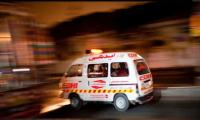PESHAWAR: A retired senior civil servant, Habibullah Khan Khattak, has said Khyber Pakhtunkhwa (KP) would become the worst affected province from coronavirus in Pakistan due to a number of factors.
Talking to The News, he listed seven reasons that were expected to push up the incidence of the COVID-19 in the conflict-affected province. Habibullah Khattak, who served for years in KP in senior positions, noted that the speed of spreading of the disease in the province was higher than the other provinces in owing to its population density. Second, he pointed out that there were already confirmed cases of coronavirus in some of the remote areas in KP. The third reason mentioned by him was the “irresponsible and casual attitude” of the people in the province despite appeals by the government, Ulema and doctors to stay home and avoid gatherings.
According to Habibullah Khattak, the presence of half-educated clerics and peshimams who lead the prayers in mosques could mislead the masses and affect campaigns against the spread of coronavirus. He mentioned the existence of Afghan refugees’ camps as another factor that would contribute to the coronavirus crisis in the province as KP has been hosting the highest number of these refugees for more than four decades.
He added that the trans-border movement of people is another contributing factor for any rise in the number of COVID-19 patients in the province. KP has a long border with Afghanistan. Also, a sizeable number of its residents regularly travel to Iran and Iraq via Balochistan to visit holy sites in Mashhad, Qom and Karbala. Many of these ‘zaireen’ brought the coronavirus to Pakistan after contracting the disease during their pilgrimage to virus-hit Iran.
In his view, the seventh reason that is likely to make KP the worst affected province from coronavirus in Pakistan is the non-mobilization of community leaders until now to help tackle the highly infectious disease by creating awareness, maintaining social distancing and isolating those already affected.
This representational image shows the hands of an incarcerated person. — AFP/FileJAMRUD: A man was arrested after a...
An old man covering himself with an umbrella during rain in Peshawar. — APP/FilePESHAWAR: Two more people were...
Azad Jammu and Kashmir Prime Minister Chaudhry Anwar-ul-Haq. — X/@KashmiriTales/FileISLAMABAD: Prime Minister Azad...
A police official stands guard outside the Peshawar High Court in this file photo. — APP/FilePESHAWAR: The Peshawar...
Advisor to the Prime Minister on Kashmir Affairs and Gilgit Baltistan Mr. Qamar Zaman Kaira addresses an important...
A representational image showing ambulances parked at an incident site. — Facebook/Rescue 1122...







